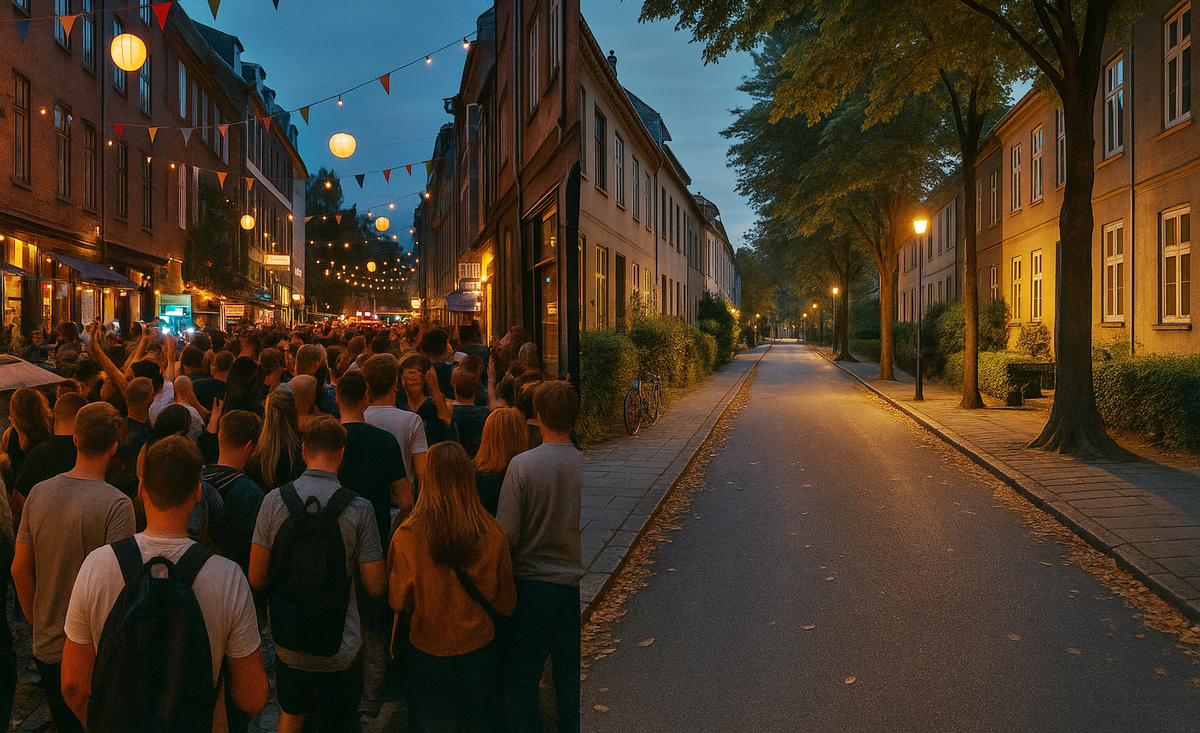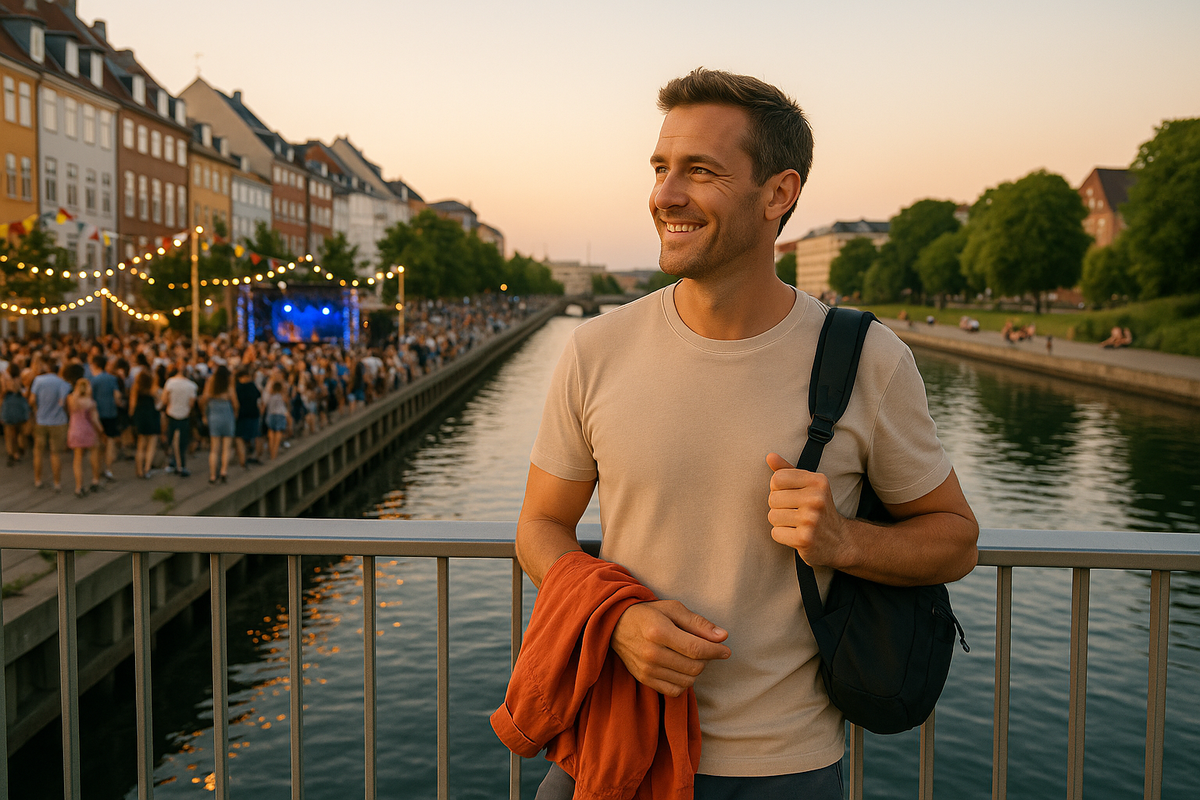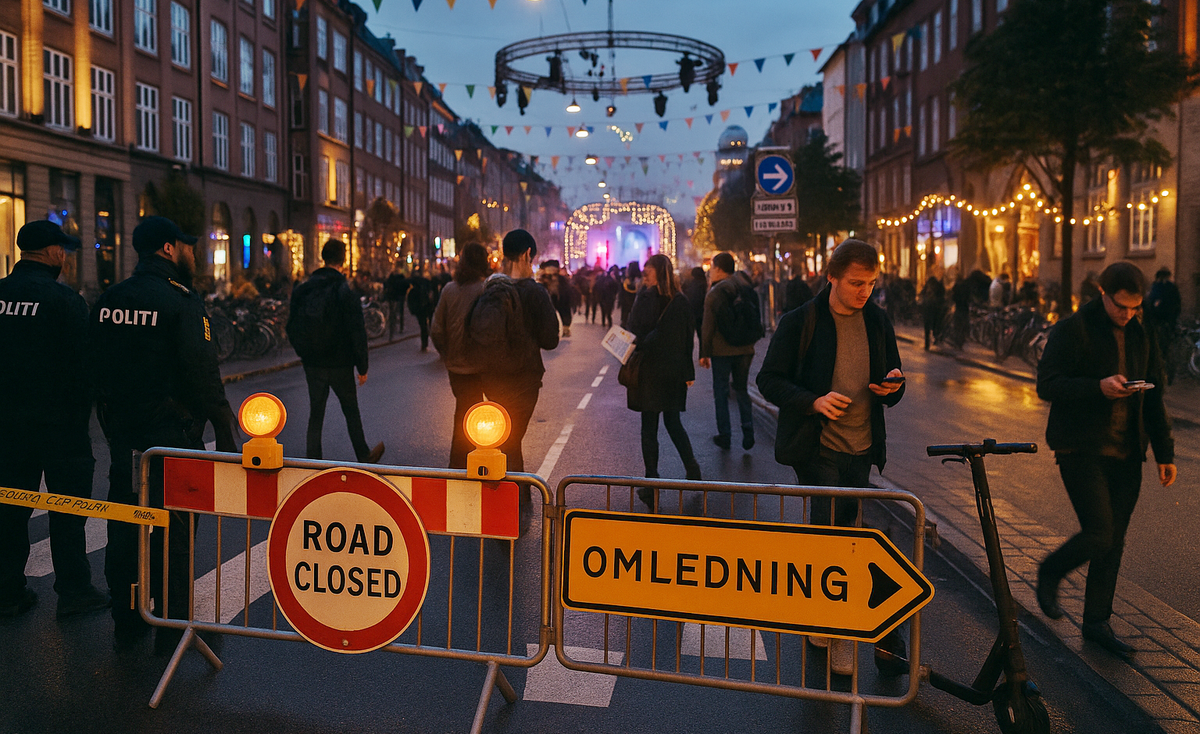🎛️ Distortion Festival (June): to go or not to go? 3–4 days, taking into account road closures
🎧 The Distortion Festival in early June transforms Copenhagen into a week of street raves, club nights and a final open-air concert at Refshaleøen. It's beautiful and powerful, but along with the music, the city experiences road closures, noise until late at night and price hikes in the ‘festival’ areas. This article will help you decide honestly: is Distortion your thing, or is it better to spend the same 3-4 days in the city, but with a light ‘anti-noise’ mode.
🎚️ What is Distortion and how does it work?

🎵 Festival format
Distortion is a week-long street and club culture festival, which usually takes place in the week ending on the first Saturday in June. Every day it moves to a new area: during the day and in the evening there are free street parties, at night there is Distortion Club, and on the final days there is the paid Distortion Ø festival on the industrial island of Refshaleøen.
During the day, the area looks almost normal, but by 4 p.m., the squares and streets are filled with stages, bars and crowds, and by nightfall, everything shifts to clubs and closed venues. The weekend finale on Refshaleøen is already a classic large electronic festival with multiple stages, lights, art installations and a sea of people.
🗺️ Areas and time slots
In a typical year, the street blocks revolve around:
- Nørrebro — dense residential development, bridges, courtyards, a very ‘local’ vibe;
- Vesterbro — a former working-class area, now home to gastro bars and pubs;
- Inner Harbour — stages along the water;
- Refshaleøen — venue for Distortion Ø.
Approximate time slots:
- 4:00 p.m. to 10:00 p.m. — street parties: music, dancing, street closures;
- after 22:00 — club events and Distortion Club;
- Friday–Saturday — Distortion Ø at Refshaleøen until late at night.
🧭 Who will enjoy Distortion, and who won't

🎉 Who will enjoy the festival
Distortion is for you if you:
- love electronic music, street culture and the ‘city as one big party’ format;
- are not afraid of crowds and high density of people on the streets;
- are willing to put up with noise until nightfall, queues at the bar and ‘delayed sleep’;
- want to combine daytime walks and museums with evening street raves.
😵 Who should plan for ‘anti-noise’
It is better to avoid the festival week or at least stay away from the epicentres if you:
- are travelling with small children or are very sensitive to noise;
- are counting on quiet evenings and long sleeps;
- want to spend 3-4 days in ‘museums, canals, neighbourhoods, a little gastronomy’ mode, rather than ‘crowds, bass and plastic beer’ mode.
🏙️ Where to stay: noisy and quiet areas

🔊 Areas with increased noise
If you are specifically travelling for Distortion and want to be in the thick of things, the following areas are suitable:
- Nørrebro — the most festival-like area during its street parties;
- Vesterbro / Kødbyen — lots of bars, clubs, evening events;
- the centre (Indre By, around Rådhuspladsen) — convenient to get to any location, but it can also be noisy here during the festival.
Keep in mind that during these days:
- traffic will be partially blocked;
- dense crowds outside your windows in the evening are normal;
- taxis and car sharing services may not be able to get right to your door.
🌿 Quiet bases
If Distortion is more of a backdrop than a destination, it makes sense to look at quieter areas:
- Østerbro — family-friendly, green, quiet, yet only 10–15 minutes by metro/bike to the centre;
- Frederiksberg — a ‘city within a city’: lots of parks, cafés, less night-time noise;
- part of Islands Brygge — convenient for access to the centre and the waterfront, but it's still worth checking the event map for the specific year.
🧩 Conditional ‘perception map’:
- Nørrebro / Vesterbro / centre — maximum traffic and congestion;
- Østerbro / Frederiksberg — live peacefully and go out when you want;
- Islands Brygge — a compromise ‘close, but not in the thick of it’.
📅 Plan for 3–4 days: festival and ‘anti-noise’ scenarios

🎛️ Scenario A: ‘Going for Distortion’ (3–4 days)
Day 1 — Neighbourhood Day (Nørrebro or Vesterbro)
- Morning: quiet activities — canal tour, short walk through the centre, light lunch.
- Day until 15:00: museum block (e.g. SMK / Glyptotek) away from future traffic jams.
- 4:00–10:00 p.m.: Street parties in ‘your’ neighbourhood — music, stages, bar courts, endless crowds.
- After 10:00 p.m.: If you want — Distortion Club/night venues, check the programme and locations in advance.
Day 2 — Distortion Ø at Refshaleøen
- Morning/day: late rise, brunch, possibly a light walk along the water, no busy plans.
- Evening and night: Distortion Ø — the main festival experience, several stages, lights, art, crowds of people until late at night.
Day 3 — ‘Recovery Day’
- Don't plan any early excursions or long trips.
- Quiet city centre, parks, coffee shops, possibly a sauna/bathhouse to ‘reboot’.
👉 If you're taking 4 days, it makes sense to add another ‘non-festival’ day before or after — to get to know the city without the noise.
🧩 Scenario B: ‘In the city during Distortion, but without the crowds’ (3–4 days)
The idea: use the festival days as triggers for outings, not as a backdrop for stress.
Day 1 — Copenhagen without Distortion
- The classics: the city centre, Nyhavn, the canals, one or two museums.
- In the evening — a quiet dinner in the neighbourhood (Østerbro/Frederiksberg), a light walk.
Day 2 — Day trip on ‘neighbourhood day’
For example, if today is street party day in Nørrebro:
- Morning: trip to Roskilde (cathedral, Viking museum).
- Day: walk around the city, coffee, return in the evening when the main crowd has already dispersed.
- Evening: dinner and hygge in a quiet neighbourhood, at most — watch the lights from afar.
Day 3 — Castle Zealand
- Trip to Hillerød (Frederiksborg) or Helsingør (Kronborg), walks in the park and along the waterfront.
- Return closer to sunset, evening — in the neighbourhood where you are staying, without going to the epicentre of Distortion.
If there is a fourth day, you can:
- repeat one of the trips in a more relaxed format;
- or, conversely, set aside the evening to briefly ‘drop in’ on Distortion, but live in a quiet area and be able to leave quickly.
🚇 Transport, road closures and navigation

🚦 How Distortion affects travel
On street party days:
- some streets and squares are closed to cars;
- bus routes may change their routes or skip stops in the festival area;
- taxis and car sharing services sometimes do not accept orders ‘inside’ the closed-off area.
Therefore, the basic approach is:
- rely on the underground, S-tog and walking routes;
- plan your travel around the city before 3 p.m., before the main roads are closed;
- keep in mind the nearest underground stations outside the epicentre — it is easiest to ‘evacuate’ there at night.
🧾 Travel passes and cards
- For active travel around the city these days, it is convenient to get a City Pass for the zones you need (1–4 or 1–99) — no need to think about tickets, just hop on any train/metro/bus.
- If you are planning to visit castles and Roskilde, it makes sense to consider the payback of the Copenhagen Card – Discover: it covers transport to Roskilde/Helsingør/Hillerød and some of the entrance fees to castles and museums.
📌 If your hotel is in an area of potential closures:
- check the map in advance to see which metro/train station is easiest to walk to;
- allow +10–15 minutes to get around the stage and crowds;
- do not plan tight schedules for these evenings (e.g., transfer to the airport directly through the party area).
💸 Budget, booking and common mistakes
💰 Prices and bookings
Festival week = increased demand for accommodation in the Nørrebro, Vesterbro and city centre areas:
- prices may rise as high as during peak summer dates;
- hostels and apartments ‘close to the scene’ are in high demand;
- it is wise to book 6–8 weeks in advance and monitor price dynamics for different dates.
If Distortion is not important to you, it makes sense to either:
- postpone your trip to the neighbouring weeks;
- or stay in a quiet area and not overpay for a ‘view of the stage’.
😬 Mistakes to avoid
- Booking a hotel in the heart of Nørrebro/Vesterbro without realising that there will be music and crowds until late at night.
- Planning complicated logistics for the festival days: transfers to the airport, tight train connections, strict time slots.
- Planning the ‘perfect museum day’ for the evening, when half of the transport and streets are operating with delays.
🧠 Life hacks
- Essential items: earplugs, comfortable shoes, power bank, a layer of clothing ‘for an evening outdoors’.
- Plan at least one ‘quiet evening’ away from the epicentre of Distortion — a walk around Østerbro/Frederiksberg, dinner without loud speakers.
- If you are going to Distortion Ø or clubs — it is better to buy tickets in advance, as popular events often sell out.
✅ Conclusion: to go or not to go during Distortion?

If you love electronic music, the atmosphere of a huge city festival, and are ready to accept noise and chaos as part of the experience, Distortion gives you a unique opportunity to see Copenhagen at its best. In 3-4 days, you can catch the festival nights and see the city during the day if you manage your time wisely.
If your ideal Copenhagen is canals, coffee shops, museums and quiet evenings, the festival week doesn't have to be a problem: just choose a quiet area, do the complicated logistics in the morning/daytime, and on the ‘hot’ evenings, go on outings or stay away from the host areas.
The main thing is to consciously choose your scenario: either play by Distortion's rules and dance with the city until morning, or plan your route so that the festival is just a bright backdrop rather than a source of stress.
❓FAQ
💡 If you like parties and electronic music, Distortion will give you a powerful ‘city-as-a-festival’ experience, but if you want a quiet first visit with museums and walks, it's better to choose other dates.
💡 The noisiest areas are Nørrebro, Vesterbro and the centre near the stages, while Østerbro, Frederiksberg and part of Islands Brygge are usually quieter.
💡 It's best to visit museums and go for walks until 3 p.m., and then head to the street party area or Distortion Ø after 4 p.m., leaving the next morning as free as possible.
💡 On street party days, you can take a day trip to Roskilde or the castles of Zealand, returning in the evening to a quiet residential area with minimal overlap with the festival areas.
💡 During the street parties, some streets are closed and buses change their routes, so it's best to rely on the metro/S-tog, plan key journeys during the day and think in advance about detours to your hotel.





0 comments
Log in to leave a comment